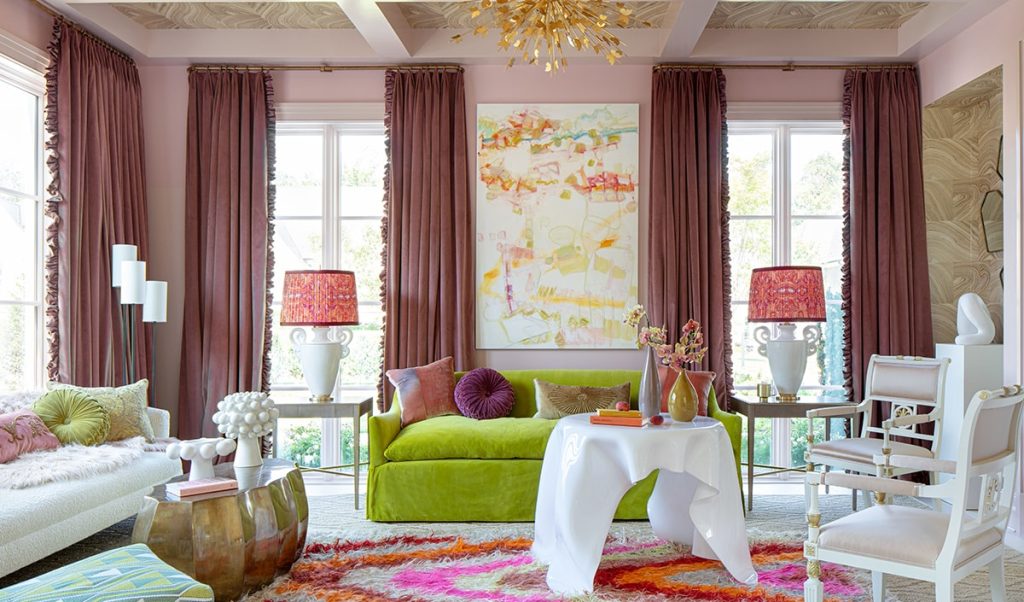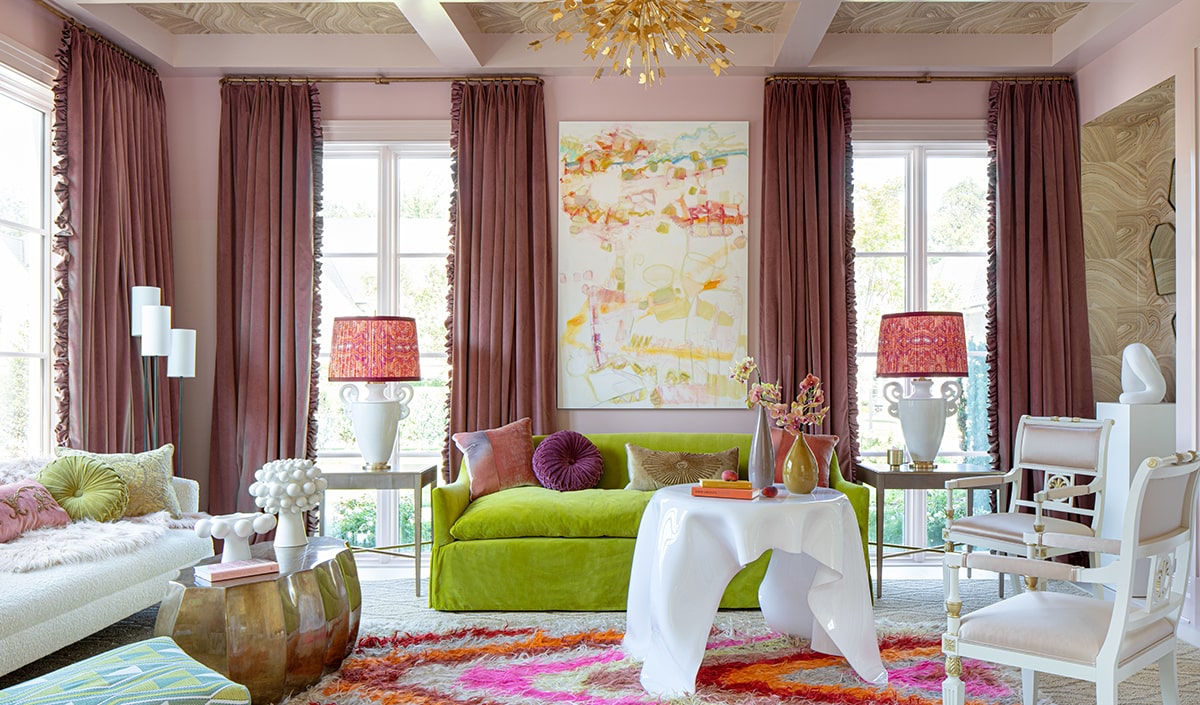How to Dress Your home With Seasoned Designer Janie Molster
Dolce spoke with interior designer Janie Molster from her home in North Carolina about her philosophy when it comes to dressing your home your way, filtered through a lens of irreverent design and boho flair.
Janie Molster’s designs are completely imperfect. It’s for this reason, among others, that her work stands out from the crowd. “After installation, when we’ve fluffed every pillow and dimmed every light, and the candle is burning and we’re walking out of the room, and I look back, my overwhelming knee jerk inclination is to go mess something up. It’s just a little bit too perfect. That’s something that I always try to bring to the table, because if it’s too perfect, you kind of want to walk past that room.” Having grown up in rural northeastern North Carolina, Molster’s ability to create a welcoming home speaks to her Southern charm and warm nature, “You want a house where you open the door and you feel like the house is embracing you and drawing you in visually. I don’t want the house to be so intimidating that you feel like you’re in a museum.”
The pages of her first monograph, House Dressing: Interiors for Colorful Living (published by The Monacelli Press), which is dedicated to her five children and husband, John, Molster, invite you to take a look at the spaces that are always intended to, “make people become more in touch with and raise the bar of their aesthetic,” including her very own urban farmhouse. Each vibrant project gives insight on how to work with colour, pattern and texture, while always staying sophisticated and finely attuned to their occupant.
Q: When did you have the “aha!” moment of when you knew you wanted to get started in interior design?
JM: I thought I was going to be an English teacher and was very excited about it. Then I married relatively young, shortly after college, and began a family very quickly, and some of that got derailed for a bit. But it was really when I had worked on our first home, and I joke that I was very long on ideas and very low on budget, just trying to be creative and trying to pull it all together. From that point, what happened is a few friends would come to visit or come for dinner and say, “Would you help me pick out a paint colour? Would you help me arrange my furniture?” And, it started to then be the friend of the friend, of the friend. One day, it was my birthday, and a couple of my girlfriends took me to lunch, and my birthday cards were business cards that they had had printed for me. They were like, “You’ve got to take this plunge,” so I always say that design found me. I just kept looking the other way for a long time. Finally, I heard it, and it was definitely something I should always do. I was rearranging my room as a child. I would paint my college apartments just so that I could stand to live in them for five months, you know? I’ve always been very impacted by my environment, so it just took me a while to hear that.
Q: What is your advice for designers coming out of school?
JM: When I think of people like Sister Parish and people like that who came through the design world without formal education and what that does is, you make a lot of errors. It’s trial by fire, and so the education piece of the design career to me is so important. What I find is that all the design schools, which I either have interns rotating through or have new hires from, being an interior designer in a residential community, you have to really be an apprentice in a firm. They don’t really teach it in the design schools. My advice when I visit them is to apply to design firms where you love the work that’s happening, because you’re going to learn more in your first year of work than you could possibly learn in a two- or four-year education program. So, of course, I’ve done continuing education, we all have to do that, but it was definitely a trial by fire. In the first 10 years of my career, I don’t even like to think of the profit margins, because I was eating mistakes left and right, but you definitely learn quickly that way. I’m just so envious of the people that I hire that are coming out of design school with so many wonderful technological skills. That’s just so advantageous for our firm to have that available.
Q: In your book, you speak on designing a space that reflects who you are. Why is this important?
JM: Some days, I’ve got head to toe Lululemon on, and it’s not your everyday, but that’s why looking in a closet reveals so much. It’s got the whole gamut of what you like to wear, and you really get a sense of it. I don’t do really well in wearing prints, and I don’t use a lot of prints in my own home. But yet, I do use them in some clients’ houses. It’s just a personal preference for me. When you’re able to find out personal preferences and incorporate it into an interior, I’m convinced people are happier in their house. It just brings them more pleasure to walk in and see a space that really tells you a lot about a person.
“When you’re able to Find out personal Preferences and Incorporate it into An interior, I’m Convinced people are Happier in their house”
Q: Why do you believe that interior design is just so important for everyday life?
JM: I encourage people to really take stock of what is around them. We all love to go to beautiful places, beautiful scenic vacations. We are innately visual people. People have to realize that whether it’s very obvious to someone, like someone like me that knows that their environment impacts them, or if it’s somebody who’s not even aware that it’s happening on some subterranean level, I can tell you that if it becomes visually pleasing to you and you become more aware, it’s going to bring you so much enjoyment. So that’s my goal: having people become more in touch with their esthetic and raising the bar of their esthetic. So, a lot of it is education and psychiatry. Sometimes, they even say to me, “What should I like?” I say, “Oh, no, no, no, I’m not going to tell you what you should like; we’re going to figure out what you like. We’re going to take the time, do the research and get to the bottom of it.”
Q: How were you able to grow such a beautiful family while also building your career? What would be your advice for women?
JM: I say this to my team, which is all women, too, “When that hard decision comes when you’re looking at the ‘most important meeting of my career,’ and daughter’s ballet recital, it’s daughter’s ballet recital. It’s always family. You’ll never look back and regret putting family first.” You know, I started off, and things were going really well, but then I had 10 years or so … I remember something was published, and the writer who had reached out to me, said, “Oh my God, I think I wrote something about you 10 years ago — where have you been?” And I said, “Well, I’ve just been trying to keep my foot in the door, because I’ve had a lot of other things pulling at me in other directions, and I don’t regret that at all.” I’m so glad I made the choice to put family first during the crunch years. The babies are easy. It’s the older children that really need you to be present emotionally. So, that would be the piece of advice that I would give to young mothers: always choose family. The career is such a side gig to being a mother.
Q: What’s one object you can’t live without?
JM: I have a beautiful ring on my middle finger that my husband gave me that’s a white sapphire. I wake up every morning and that’s the first thing that I reach for. I wear it every day. It brings me so much happiness. That’s something I can’t live without, not necessarily an interior design element, but a personal one.
Q: What is your biggest interior design pet peeve?
JM: Short lamps drive me crazy. When you have a lamp in the room, ideally the lamp is there to create ambient light and also to illuminate. Say you’re reading a book, sewing on a button, the light should cast over a shoulder when you’re sitting, and these lamps that are so short are basically casting a light at your lap. They make a room feel short; that drives me crazy.
Q: How has the pandemic affected your view on life?
JM: My daughter laughs all the time because I always say, “It’s not a dress rehearsal, honey, just go for it. This is the real play. Just go for it the whole time.” The pandemic really brought that message home for me — just how lucky we all are. But how that relates to an interior, I do touch on this in my book, is some people always say, “Oh well, we can’t have that, because we have a toddler.” And I always say, “Let me tell you, the toddler quickly becomes the messy school-aged child that’s bringing home sporting equipment and dirty shoes, and that quickly leads into a college boy who’s bringing home 10 cases of beer. And don’t forget about the grandparent visiting who’s stashing away red wine and your friends that are eating Chinese food on your white sofa, or your puppy.” I said, “There’s just always something you can say. I just can’t have this quite yet.” My opinion is you can have it; you just have to figure out a way to make it durable. Don’t wait to design your house, if you have the financial means to move forward. Go ahead and do it now; there’s always some reason to put it off because of vulnerability.
Q: And what would you say inspires you most?
JM: A lot of designers are probably not completely forthcoming about this, but I would tell you that I’m inspired by my peers. I really am. When I get a new design magazine, and I open it up, I can’t hear anything around me. I’m so immersed. I’m so amazed by the talent of my contemporaries. Of course, everyone says, “I’m inspired by travel, I’m inspired by art.” But, I’m also really inspired by other designers and their amazing creativity.
Q: What makes you feel at peace?
JM: A bed that is dressed with really, really great linens. My kids laugh so hard because they’ll all come and jump in my bed, and whatever, and I’m like, “Whoa, whoa, whoa. This is my little area. This is my safe place. This is my happy place.” If I’m going through someone’s budget on a design, I’m always going, “We need to add a little more on the bed. We need to pad the bed budget, because we spend so much time there.” People lead such busy lives; we’re all pulled in so many directions, and when you slide into bed, we need the best mattress, we need the nicest sheets, the duvet or the blankets that fit you exactly, whether you’re hot or cool at night. So, getting the bed just right, to me, is so important to me, and my bed brings me such peace and happiness.
Q: What would you say to your younger self?
JM: I would say, “Be patient. You’re going to have an opportunity to do all of this.” I work now more than I ever have, because I can. To your point earlier about the family, I have more time to work, and work brings me such fulfilment so I would say, “Be patient. All these things are going to happen, and it doesn’t all have to happen in the same year.” And, back to the “it’s not a dress rehearsal,” just take advantage of friends and family and opportunities to be together. I always prioritize that and try to create homes and vacation homes that draw people to do that. So, I would say to my younger self, “Just be patient. It’s all going to happen.”
Q: What does la dolce vita mean to you?
JM: I immediately think of this past weekend in my life. We had this little house down here at the beach in North Carolina filled with tons of family and friends. We had two beautiful outdoor dinners and sat outside on porches together. My kids, who are musical, we sang around the guitar, and, I mean, how does it get any better than that? To me, if I could make a picture of that, that’s what I would call that.


























































































